Pest control is a necessary thing for every farmer and gardener. We’ve all been there.
There are so many examples of how pest control can do more harm than benefits. Naturally, this should be prevented.
That is why I decided to point out several things important for eco-friendly pest control.
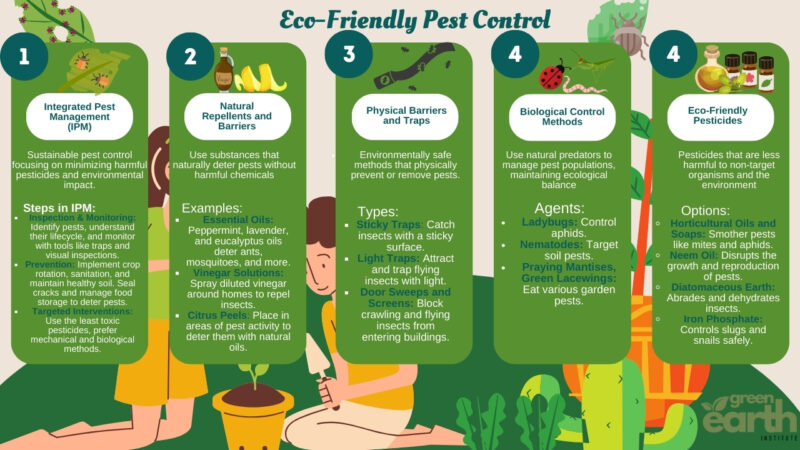
Integrated Pest Management (IPM)
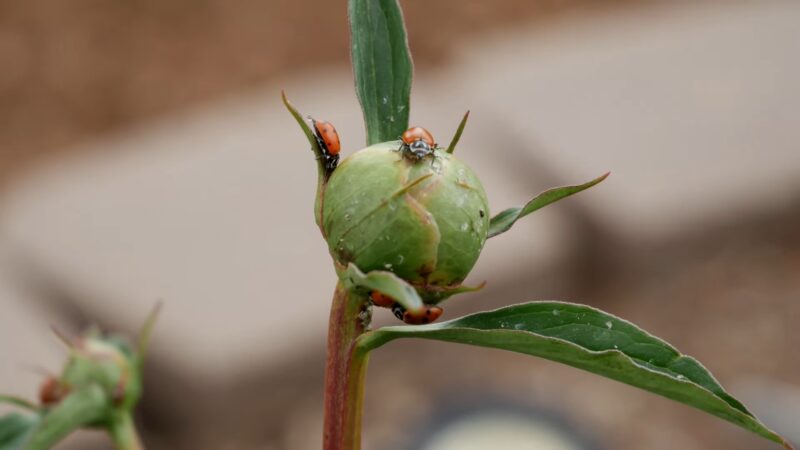
Integrated Pest Management (IPM) is a sustainable approach to pest control that emphasizes the use of comprehensive, environmentally sensitive strategies.
The goal of IPM is to minimize the use of harmful pesticides and to reduce the negative impacts of pest management on the environment.
This approach involves several critical steps:
Inspection and Monitoring
The first step in IPM is to conduct a thorough inspection of the area and continuous monitoring.
It involves identifying the types of pests present and understanding their lifecycle and behavior. Monitoring tools might include traps, visual inspections, and even using technology to track pest populations.
It helps in making informed decisions about the necessity and type of control methods to be used.
Prevention
Preventive measures are crucial in IPM and focus on keeping pests from becoming a problem in the first place. This includes cultural practices such as crop rotation, sanitation, and the maintenance of healthy soil.
Structural prevention might involve sealing cracks to prevent entry into buildings and proper food storage to reduce attraction.
Targeted Interventions
When intervention is necessary, IPM promotes targeted and minimal use of pesticides. The choice of intervention depends on the specific pests and situation.
These might include mechanical methods like using traps or barriers, biological controls like introducing natural predators, or chemical methods, employing the least toxic pesticides as a last resort.
The key here is precision—targeting the pest without affecting other organisms or the environment negatively.
Natural Repellents and Barriers
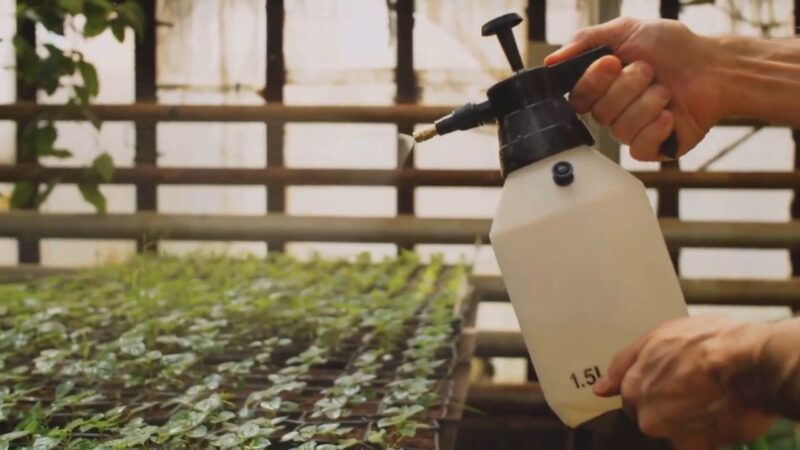
Employing natural repellents and physical barriers offers an effective and eco-friendly alternative to chemical pesticides. These methods are safer for both the environment and human health.
Natural Repellents
Natural repellents serve as a gentle yet effective means to deter pests without resorting to harsh chemicals.
Here’s a more detailed look at some of these natural repellents:
Essential Oils
Essential oils are concentrated liquids containing volatile aroma compounds from plants, known for their strong scents and medicinal properties. In pest control, they are used primarily for their potent repellent qualities.
- Peppermint Oil: Peppermint oil is highly effective against spiders, ants, and mosquitoes.
- Lavender Oil: Renowned for its calming properties in aromatherapy, lavender oil also repels a variety of insects, including moths, fleas, and flies.
- Eucalyptus Oil: This oil has a sharp, camphor-like smell that is especially disliked by mosquitoes and ticks.
These oils can be used in several ways, including diffusers, in a diluted spray solution, or even directly applied to areas like baseboards or the edges of windows where pests enter.
Vinegar Solutions
Vinegar, particularly white vinegar, is acidic and can effectively repel several types of insects.
- General Repellent: A mixture of equal parts water and vinegar can be sprayed around the perimeter of a home, across door thresholds, and around window sills.
- Targeted Applications: For fruit flies, a small bowl containing vinegar and a drop of dish soap acts as an effective trap.
Citrus Peels
The oils found in citrus peels, such as those from oranges, lemons, and grapefruits, contain limonene and linalool, which are toxic to many house pests.
- Direct Use: Placing fresh citrus peels directly in areas of pest activity can deter their presence.
- Boiled Peels: Boiling citrus peels in water can create a concentrated solution that, when cooled, can be used as a spray for both indoor and outdoor pest control.
Physical Barriers and Traps
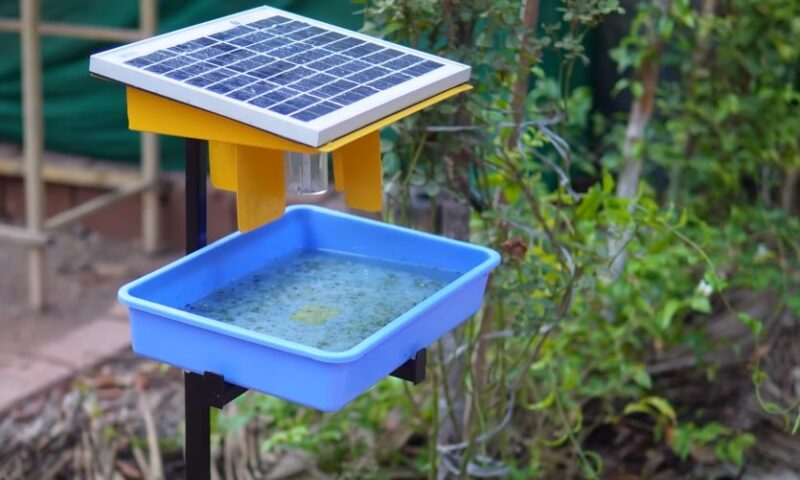
Physical barriers and traps are indispensable tools in pest management, serving as both deterrents and methods to control pest populations. These methods are environmentally friendly, as they do not rely on chemicals, making them safe for use in homes, especially where children and pets are present.
Sticky Traps
Sticky traps are a straightforward yet effective way to manage insect populations. They consist of a surface coated with a strong adhesive that catches and holds pests that come into contact with it.
- Types and Placement
-
-
- These traps come in various sizes and can be placed near suspected entry points, around plants, or in any area where pests are frequently seen.
- They are particularly useful against flying insects such as flies, mosquitoes, and moths.
-
- Indicator of Pest Presence
-
- Sticky traps are an excellent monitoring tool.
- The number and type of pests captured can help identify the level of infestation and monitor the effectiveness of other measures.
Light Traps
Light traps use a light source to attract and then capture or kill flying insects. They are particularly effective at night when the light from the trap is the main light source visible to insects.
- Functionality
-
-
- These traps typically consist of a light bulb surrounded by a cage or enclosure with an adhesive surface or an electrified grid.
- Insects are attracted to the light and either get stuck on the adhesive or are electrocuted by the grid.
-
- Applications
-
- Light traps are ideal for areas where chemical use is undesirable, such as kitchens, hospitals, and food processing plants.
- They help reduce flying insects like moths, beetles, and flies without spreading toxins into the environment.
Door Sweeps and Screens
Door sweeps and window screens are simple yet crucial physical barriers that prevent pests from entering buildings.
- Door Sweeps
-
-
- These are attached to the bottom of the doors and serve to close the gap between the door bottom and the threshold.
- Effective door sweeps keep out crawling insects like ants, spiders, and even small rodents.
-
- Screens
-
- Installing screens on windows and ventilation holes blocks an important entry point for flies, mosquitoes, and other flying insects.
- It’s important to ensure that the screens are well-fitted and free from tears or holes to maintain their effectiveness.
Biological Control Methods

Biological control involves the use of living organisms to reduce pest populations. These natural predators can effectively manage pests with minimal environmental impact. Here are the most widespread ones:
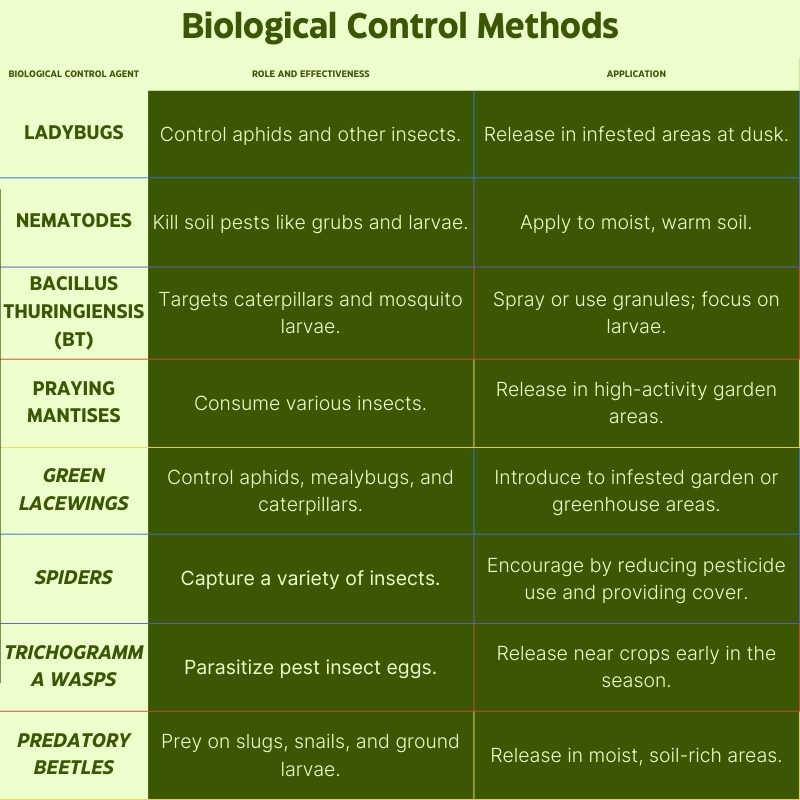
Biological control methods are advantageous because they usually target specific pests, reducing the chance of harming non-target species and maintaining ecological balance.
Eco-Friendly Pesticides and Products
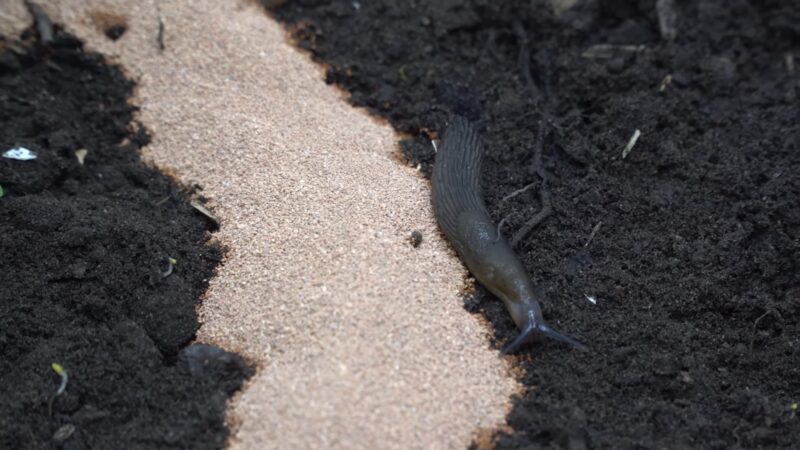
Eco-friendly pesticides and products provide a vital alternative to conventional chemical pesticides by using substances that are inherently less toxic to both non-target organisms and the environment.
These products degrade more rapidly and are less likely to contribute to long-term environmental damage.
Horticultural Oils and Soaps
Horticultural oils and insecticidal soaps are designed to smother pests such as mites, aphids, and whiteflies upon contact. They coat the insects’ bodies, disrupting their normal functions like breathing and feeding.
These are typically diluted with water and sprayed directly onto the affected plants. It’s crucial to cover both the tops and undersides of leaves to ensure effective pest control. They are best used in cooler temperatures to avoid damaging the plants.
Neem Oil
Extracted from the seeds of the neem tree, neem oil acts as a potent growth regulator and repellent to many insect pests, affecting larvae, nymphs, and adult stages. It disrupts hormonal balance, preventing pests from developing and reproducing.
Neem oil can be applied as a foliar spray or a soil drench, depending on the pest and plant involved. Consistent applications are necessary, as the oil also degrades rapidly in the environment, reducing residual impact.
Diatomaceous Earth
This powder is composed of the fossilized remains of tiny aquatic organisms known as diatoms.
The sharp edges of diatoms cut through the exoskeletons of insects, leading to dehydration and death. Diatomaceous earth can be sprinkled around the base of plants or on the foliage.
It is most effective when dry, as moisture reduces its ability to abrade the insects.
Iron Phosphate
Iron phosphate is a safer alternative to more hazardous molluscicides for controlling slugs and snails.
It causes them to stop feeding almost immediately after ingestion, leading to their death within a few days. The compound is typically formulated as pellets that can be scattered around areas where slug and snail activity is problematic.
It is non-toxic to wildlife and pets and is safe to use around edible plants.
Summary
Paying attention to the best eco-friendly pest controls available out there is of utmost importance.
Differentiating between eco-friendly options and those that can harm the plants is another crucial thing.
Make sure you know the difference before you utilize it.
Harley Wilson, from Vermont, carries on a family legacy of organic farming, with a focus on supporting pollinators. Inherited his farm from his grandfather, his dedication to the land Harley also teaches his children the value of hard work through hard work.
Related Posts:
- How to Implement Eco-Friendly Farm Practices From the Start
- What are Cover Crops and How Do They Help Keep Soil Healthy?
- How to Create a Buzz with Pollinator-Friendly…
- Composting - Turning Your Waste into Gold, As Alchemists Do
- How to Maximize Space in Your Organic Garden
- Why is Plant Diversity Important for Your Garden

